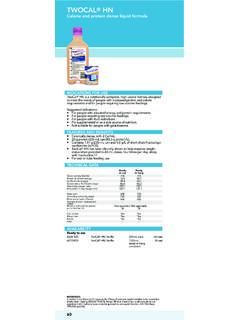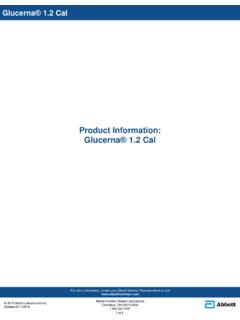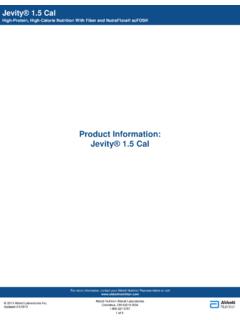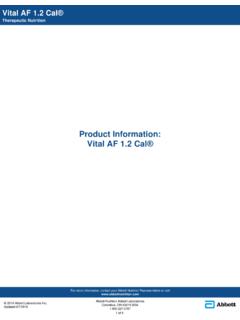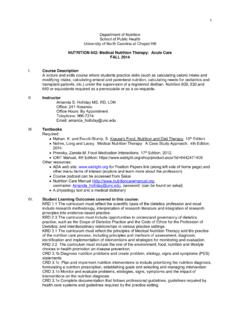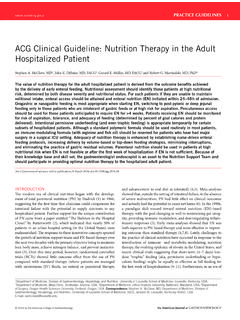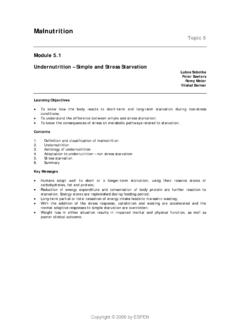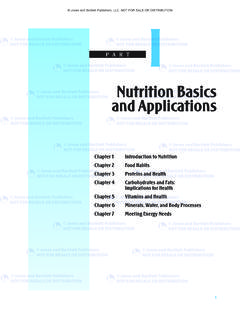Transcription of Blenderized Feeds - Abbott Nutrition
1 Blenderized FeedsFeed patients right. feed patients now. INTRODUCTIONA cross many centuries, the early history of Nutrition was filled with accounts of feeding brandy, milk, raw eggs, and meat broths by way of the rectum or the upper gastrointestinal ,2 By the mid-20th century, hospital staff members began blenderizing foods cooked in hospital kitchens to create liquid mixtures containing a wider range of nutrients. Then in the 1970s commercial formulas of defined composition were introduced for tube ,2 Now in the 21st century, Nutrition is given as therapy rather than as simple sustenance. This includes standard formulas with or without added fiber, and disease-specific formulas for people with diabetes, cancer, and pulmonary or renal In addition, new immune-modulating and tolerance-promoting formulas are increasingly used to improve patient Rectal Feeding Blenderized Enteral Commercial Enteral Ready-to-hang Enteral Specialty Enteral FormulasEarly 1900s 1950197019902010 Timeline of Enteral FeedingARE Blenderized FEEDINGS STILL USED FOR ENTERAL Nutrition ?
2 In some parts of the world, for economic and cultural reasons, hospital staff members still blenderize foods to make enteral tube feeding mixtures in some Such feedings are thought to be naturally healthy and economical; study results reveal that neither belief is true. Blenderized Feeds have safety limitations that must be recognized. Due to the nature of food ingredients, these products contain bacteria, even when hospital kitchens follow clean preparation procedures. When hung at room temperature for feeding, contamination by bacterial overgrowth is likely to occur. Blenderized Feeds must be delivered to the stomach where the acidic milieu helps limit, but not eliminate, bacterial Contamination can result in patient infections that slow recovery and cause longer hospital stays and higher costs of care. Beyond risk of contamination, Blenderized Feeds have other problems too (Table 1). It is difficult to maintain batch-to-batch consistency of Blenderized It is also difficult to make Blenderized Feeds for volume-sensitive patients ( , mixtures with high caloric density).
3 5 Further, fully pureed mixtures are impossible to make, so Blenderized mixtures do not flow well through feeding Finally, Blenderized Feeds lack the benefits of pharmaconutrients, which are now included in disease-specific commercial formulas ( , short-chain fats and small peptides to help improve tolerance, omega-3 fatty acids for suppression of inflammation, and immune-modulating ingredients such as arginine and antioxidants).4 Table 1 Comparison of Blenderized Feeding Solutions With Sterile Commercial Enteral Formulations In some parts of the world, for economic and cultural reasons, hospital staff members still blenderize foods to make tube-feeding mixtures in some hospitals. Such feedings are thought to be naturally healthy and economical; study results reveal that neither belief is nutrient delivery Suitability for volume-sensitive patients Feeding tube owTolerance and immune functionLikelyNoHard to prepare as high-density nutritionPoor ow with gravity feeding or with pumpNo special ingredientsUnlikelyYe sAvailable at high-calorie densitiesFew or no ow problemsAvailable with tolerance-promoting or other pharmaconutrientsConcernBlenderizedComme rcial EnteralWHAT IS THE clinical EVIDENCE ABOUT Blenderized Feeds ?
4 Studies have shown that 90% or more of Blenderized Feeds are contaminated with unsafe levels of ,8 A study of hospital-prepared Blenderized Feeds in Iran found that 99% were unacceptably contaminated (in excess of standards set by the Parenteral and Enteral Nutrition Group of British Dietetic Association) and presented a substantial risk to patients who received Using a similar standard, a study in the Philippines found 75% to 96% of Blenderized Feeds were WHAT DO Nutrition EXPERTS SAY ABOUT Blenderized Feeds ? According to European experts on clinical Nutrition , Blenderized enteral Feeds may be necessary when ready-to-use liquid or hydrated powdered formulas cannot be obtained, as during natural Such feedings can be delivered by way of nasogastric or gastrostomy tubes to the stomach where acid provides some natural decontamination; infusion into the duodenum or jejunum is discouraged due to safety Chernoff R.
5 An overview of tube feeding: from ancient times to the future. Nutr Clin Pract. 2006;21 Harkness L. The history of enteral Nutrition therapy: from raw eggs and nasal tubes to purified amino acids and early postoperative jejunal delivery. J Am Diet Assoc. 2002;102 Campbell SM. An anthology of advances in enteral tube feeding formulations. Nutr Clin Pract. 2006;21 Hegazi RA, Wischmeyer PE. clinical review: Optimizing enteral Nutrition for critically ill patients--a simple data-driven formula. Crit Care. 2011;15 Jonkers-Schuitema C. Homemade enteral (tube) Nutrition . In: Sobotka L, ed. basics in clinical Nutrition . 4th ed. Prague: Gal n; 2011 Sullivan MM, Sorreda-Esguerra P, Platon MB, et al. Nutritional analysis of Blenderized enteral diets in the Philippines. Asia Pac J Clin Nutr. 2004;13 Jalali M, Sabzghabaee AM, Badri SS, et al. Bacterial contamination of hospital-prepared enteral tube feeding formulas in Isfahan, Iran.
6 J Res Med Sci. 2009;14 Sullivan MM, Sorreda-Esguerra P, Santos EE, et al. Bacterial contamination of Blenderized whole food and commercial enteral tube feedings in the Philippines. J Hosp Infect. 2001;49:268-273. 2014 Abbott Laboratories 5001 1113 0140 A1 feed patients right. feed patients now.

